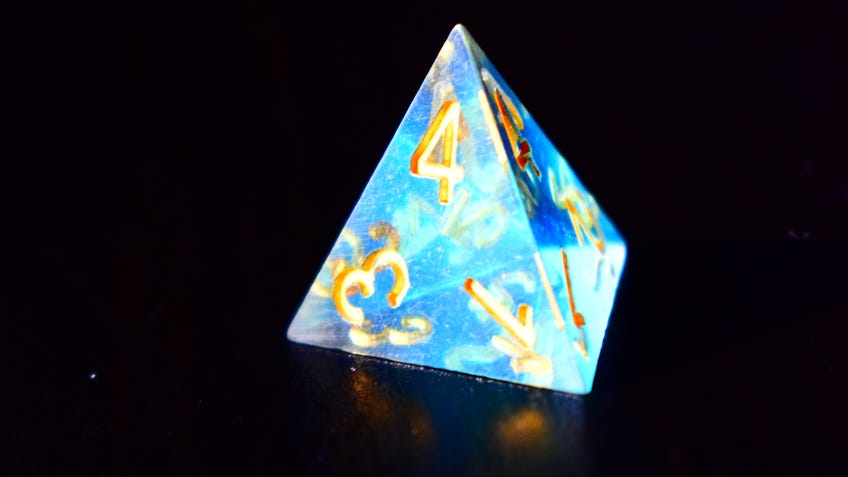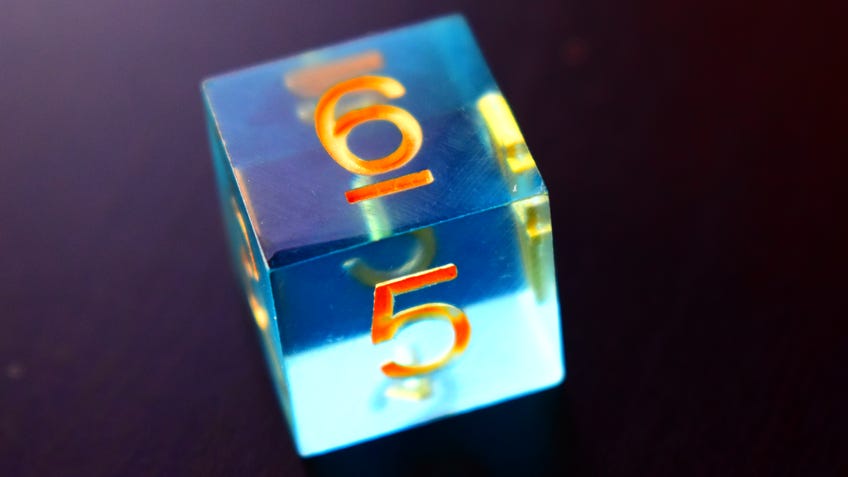Dice: The ultimate ranking, from d4 to d20
Roll call.
Dice. You use them in a lot of tabletop games. To the naked eye, they may appear to be nothing more than a tool of probability. A simple object that can be used to determine the outcome of an action or point total. But to an academic of analogue gaming, a scholar of cardboard - shall we say - dice are far more than just a means to an end; they’re a symbol of how tabletop gaming can be approached in such a variety of different ways.
Dice can be judged by their shape, size, rolling ability and general feel, alongside more idiosyncratic ways - such as whether they radiate a particularly radical energy or could be used as a form of weaponry. We’ll be judging the six main types of polyhedral dice you’re likely to see in the average board game store - get out of here, triangular and pentagonal prism dice - on no particular criteria other than what my gut, brain, heart and possibly other major organs tell me.
Without further adieu, here are the main types of polyhedral dice ranked, because reasons.
6. The D4
A small but deadly triangle whose roll leaves much to be desired

Flopping around at the very bottom of this list is the d4, the smallest and most unnecessary of all the dice. Despite having one of the best shapes in the existence of geometry - it’s hard to beat a good equilateral triangle - the d4 is easily the worst of all the polyhedral siblings.
Firstly, let’s address the elephant in the room. The way a d4 rolls is woefully pathetic. In fact, calling it a roll is an insult to the very act. Rolling a d4 is more like pushing over a particularly small walrus. For something so tiny, the d4 feels cumbersome and moves with - as one infamous Come Dine with Me contestant once remarked - all the grace of a reversing dump truck.
Despite having previously praised its shape, the d4 has the unfortunate reputation of being akin to a miniature throwable weapon. The pointy tip of a d4 has claimed many a foot in its time, acting as a better caltrop than any form of rollable object, making it something that’s worse than just embarrassing, but actually malevolent. Also, not having a set number for each side is terribly distressing - how are you supposed to know whether the result is the top or the bottom number on the die? We still don’t know for sure. Please sort yourself out, d4.
5. The D10
Rarely used and rarely necessary

Here’s another odd one, the d10. You don’t see d10s too often, mostly because they’re mainly used as a percentile die. Which seems a little like doing something different for the sake of clout rather than any real useful reason. A polyhedral set will usually come with a d10, but it often feels like a kitchen tool sold by JML or QVC - you’ll use it maybe once or twice in games like Cyberpunk, Deadlands and Vampire: The Masquerade before eventually chucking it into a drawer to rot.
This isn’t helped by how it rolls. Thanks to its distinct lack of angles, d10s do less of a roll and more of a drawn out spin manoeuvre, as if it were one very tuckered out teacup ride at Disneyland.
Talking of amusements, arguably the best feature of the d10 is that its shape is very reminiscent of a circus tent. However, this does mean that when the die is stationary, it leans a little too much to one side - as if it’s passed out from drinking one too many. Sleep deeply, you oddly bulbous die.
4. The D20
Large and imposing, the d20 is all sound and fury signifying nothing

Sure to be a controversial choice, it’s the d20. Poster child of tabletop roleplaying games such as Dungeons & Dragons, the d20 is a hulking behemoth compared to the other polyhedral dice. Its many sides allow the d20 to offer a broad range of possibilities when it comes to potential outcomes, which is likely what makes it such a popular die amongst RPG designers.
However, its greatest strength is also the d20’s most obvious weakness. The range of results on a d20 can overcomplicate an otherwise more straightforward set of outcomes - also an issue shared by a lot of roleplaying games in general - leading to unnecessary bloat.
Which is why the d20’s agility is so surprising. A d20 roll involves a good amount of little bounces and turns, showing that its size doesn’t hinder its ability to skip on a tabletop. Though the movement it produces could be a little smoother, the d20 also feels rather nice when rolled between the fingers. Nevertheless, its insistence on overcomplicating things makes the d20 feel as inaccessible as the RPG it’s known for.
3. The D12
This underrated gem charms with its delightful roll and fine form

May I present to you, winner of the best roll, the d12. It may not look like it, but this die has all the pep and fine form of a Crufts obstacle course champion. Rolling a d12 is an immensely enjoyable action due to the sheer length it travels and the smoothness with which it does it. The slightly larger and flatter nature of its pentagonal sides allows the d12 to effortlessly roll across a tabletop, with an excellent ratio of bounces to turns. Even holding a d12 feels satisfying because its sides allow it to rest comfortably between the fingertips, like a perfectly shaped ruby or particularly firm grape.
Whilst the d12 does have an odd shape - it looks a little like one of the wall tiles from an older iteration of the Tardis - it largely works in its favour. More importantly, the d12 provides a softer die than its edgier siblings. The kind of die that you could cuddle with on a cold winter’s night and not want to throw out of the bed. If you were so inclined.
2. The D8
A die with both style and substance

These last two entries were tricky to decide between, as both have very distinct styles that shine in their own special way. In the end, the d8 just about missed out on the top spot - which is not to say it doesn’t deserve to be praised to Dice Heaven and back. From the moment you look at a d8, it’s hard to ignore its pleasingly unique diamond profile. The tallest of all the polyhedral dice, the d8 has the look of some sort of ancient crystal containing the power to bend the game to your whim. More of a feeling than the actual truth, of course.
The verticality of the d8 gives it a beautifully light roll containing a series of pleasant little bounces, like an Olympic-level gymnast. Once it’s done pulling off a tight collection of forward rolls and cartwheels, the d8 naturally comes to rest tilted on its side in a reclined fashion - which perfectly encapsulates the effortless way that the d8 continues to be the coolest die in the polyhedral family. Rolling has never quite felt so radical than with a d8.
1. The D6
An undeniable crowd pleaser takes the top billing

Above everything else, Dicebreaker is about encouraging as many people as possible to get stuck into playing board games, roleplaying games, miniatures games and more tabletop goodness. Which is why the best polyhedral die is the d6. It’s the easiest to find, it’s used across the spectrum of tabletop gaming and it’s the most recognisable die in mainstream culture.There is no pretense to using a d6 - it doesn’t try to overwhelm you with weird shapes, multitudes of sides or complex probability equations.
With its solid cubic shape, the d6 may not particularly dazzle or impress. Instead, it offers a dependable and trustworthy die that doesn’t sit at odd angles or try to stab into your flesh. No, the d6 is a soft and safe child. Which is not to say that the d6 lacks flair. Rolling a d6 has a sense of gravitas about it, thanks to the die’s weight and the size of its sides causing it to make more noise when being rolled. It also has a good amount of bounce without taking things too far - here’s looking at you, d20.
More than anything, the d6 is an absolute classic. There’s a reason why it’s used in so many different types of games, from dice-rolling titles like Yahtzee to roleplaying games such as the Root RPG, which uses the Powered by the Apocalypse system, it’s a universal kind of die. Give it up for the d6, the die of the people.




